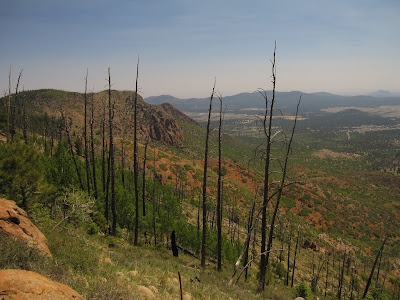Only one week until we begin out journey north to the Olympic Peninsula. But, with temperatures in the 80's, it was a great weekend to head up onto the 9,000 foot summit of Mount Elden, which is literally in our backyard. Both Linda and I had been to the summit by hiking the 2,000 foot slope previously (and individually), but we wanted Hilina to have a chance to go up there as well, so we drove up the radio tower access road to the ridgeline and then began hiking from there on the Sunset Trail.
The sky was clear, but a bit smoky from the big fires in New Mexico. But, being up on these slopes is a great lesson in fire ecology, as Mount Elden burned in a catastrophic human-caused fire in 1977. Since the fire occurred in the driest part of the year (May and June) before the summer monsoons arrived, once the fire was out and the heavy monsoon rains begun, it literally washed away all of the soil. Thus, regeneration has been painfully slow. In fact, scientists believe it will take more than 1,000 years for the ponderosa pine forest to return to its slopes.
In fact, the historically, fires in this region would not have begun until lightning strikes during the wet monsoon season started them. But, since conditions were wetter, the fires were smaller and mostly stayed on the ground, actually improving the forest ecosystems. But, most major fires of the southwest today are human caused and occur during the ultra-dry late spring (May and June) before the monsoons arrive to put them out.
But, on the north-facing slopes, which were cooler, wetter, and where the fires would have to go downslope after reaching the crest did not burn or only burned on the forest floor. As such, there trees are dense and there is a plethora of regrowth of young conifers and aspens.
 |
| The aspens are regenerating on the north-slope (left), while the south-slope is barren |
Another interesting ecological concept easy to see up on this ridge are the climatic differences between north and south aspect. North-facing slopes are cooler and wetter because they remain in the shade all winter, while south-facing slopes get the direct sunlight. Thus, snow and rain linger longer on north-facing slopes, the soils do not dry out as quickly, and the trees are less exposed to the desiccating effects of the sun. In addition, since most of the prevailing winds come from the southwest, these south-facing slopes also experience more of the desiccating winds and hoar-frost in winter.
 |
| An example closer to what these forests should look like |
The Four Forests Restoration Initiative is an attempt by the U.S. Forest Service to restore these forests back to their originally ecological state. That was large ponderosa pines, widely spaced apart, with frequent (every 5 years) low-intensity ground fires that burn off shrubs, fallen branches, and small trees that create ladders for fires to climb up into the canopy. The four national forests of Northern Arizona include the Coconino, Kaibab, Apache-Sitgreaves, and Tonto. The best way to restore these forests is through the use of thinning of small and dense trees and through frequent prescribed burns. It is critical no human-caused fires occur during the hot-dry period in May and June, but are allowed to burn (under strict monitoring) during the monsoon season of July-September.
 |
| A view down to our house, located about in the exact center of this image |
From the top of Mount Elden, you can see the entire city of Flagstaff. It is quite obvious that the city is a long linear strip following the railroad tracks and I-40 only about 2 miles wide and about 10 miles long.
 |
| Hilina and Linda relaxing on a huge old southwestern white pine snag |
Hiking up here, literally one mile as the crow flies from our home, reminded us why we moved here to Northern Arizona. The recreational opportunities are boundless. There is so much diversity, from the Sonoran Desert to dense forests to alpine meadows all within 2 hours of Flagstaff.
 |
| The 12,630 foot San Francisco Peaks from Mount Elden. They are the highest peaks in Arizona and the only true alpine area in the state. |
 |
| Flagstaff and beyond |













No comments:
Post a Comment